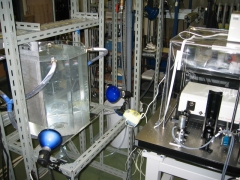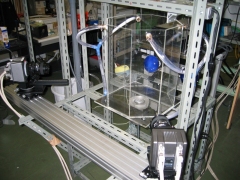Fluid Engineering Laboratory |
Fluid Engineering Laboratory |
A scanning stereo particle image velocimetry (SSPIV) system was developed to measure the three-dimensional (3D) distribution of three-component (3C) velocity in a turbulent round jet. A laser light sheet produced with a high-repetition-rate pulsed Nd:YLF laser was scanned by an optical scanner in a direction normal to the sheet. Two high-speed mega-pixel resolution C-MOS cameras captured the particle images illuminated by the light sheet, and the stereoscopic PIV method was adopted to acquire the 3D-3C velocity distribution of turbulent water flow. A water jet formed by a round nozzle with an exit diameter of D = 5 mm was diagnosed by the current technique. The jet Reynolds number was set at Re 1000, and the streamwise location of the measurement was fixed at approximately x = 45D. A measurement volume (100 mm x 100 mm x 100 mm) containing 50 velocity planes was scanned in 0.22 s, which was sufficiently short to capture the instantaneous vortical structures. The residue of the continuity equation (divergence) was approximately 7% of rms vorticity on the centreline of the jet. The iso-vorticity surfaces clearly depict vortical structures in the jet shear layer.
Hori, T., Sakakibara, J., 2004, "High Speed Scanning Stereoscopic PIV for 3D Vorticity Measurement in Liquids", Measurement Science and Technology, Vol.15, No.6, pp.1067-1078.
 Å@
Å@
Measurement system: Camera and laser, optical scanner and Plexiglass water tank
Illuminating laser light sheet
Results
Vorticity iso-surfaces of a round free jet; From left, Reynolds number = 1000, 2000 and 3000. Flow directs upward.
Temporal evolution of vorticity isosurfaces; From left, Reynolds number = 1000 and 2000